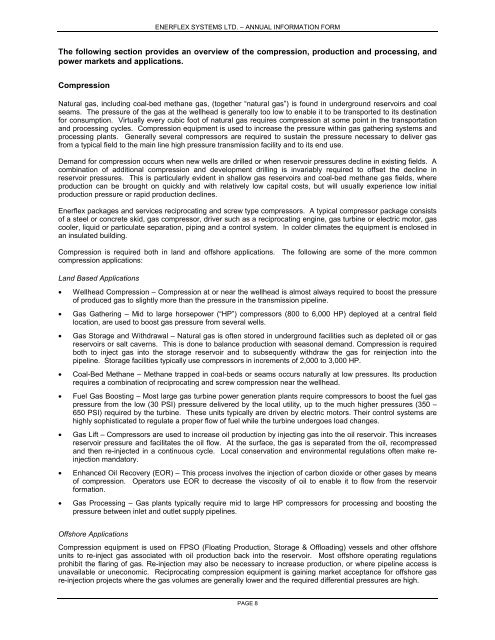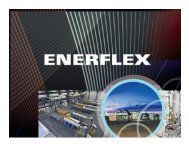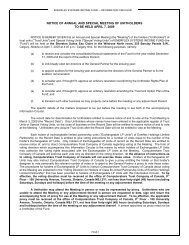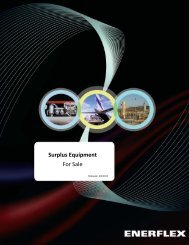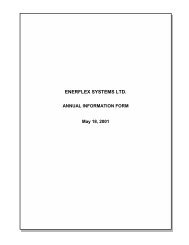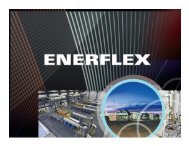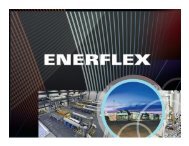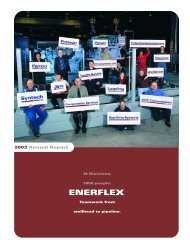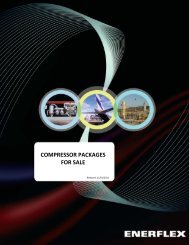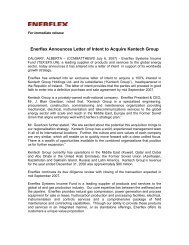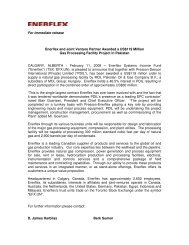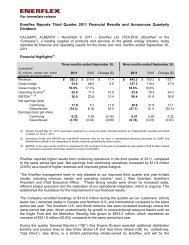ENERFLEX SYSTEMS LTD. ANNUAL INFORMATION FORM For the ...
ENERFLEX SYSTEMS LTD. ANNUAL INFORMATION FORM For the ...
ENERFLEX SYSTEMS LTD. ANNUAL INFORMATION FORM For the ...
You also want an ePaper? Increase the reach of your titles
YUMPU automatically turns print PDFs into web optimized ePapers that Google loves.
<strong>ENERFLEX</strong> <strong>SYSTEMS</strong> <strong>LTD</strong>. – <strong>ANNUAL</strong> <strong>IN<strong>FORM</strong>ATION</strong> <strong>FORM</strong><br />
The following section provides an overview of <strong>the</strong> compression, production and processing, and<br />
power markets and applications.<br />
Compression<br />
Natural gas, including coal-bed methane gas, (toge<strong>the</strong>r “natural gas”) is found in underground reservoirs and coal<br />
seams. The pressure of <strong>the</strong> gas at <strong>the</strong> wellhead is generally too low to enable it to be transported to its destination<br />
for consumption. Virtually every cubic foot of natural gas requires compression at some point in <strong>the</strong> transportation<br />
and processing cycles. Compression equipment is used to increase <strong>the</strong> pressure within gas ga<strong>the</strong>ring systems and<br />
processing plants. Generally several compressors are required to sustain <strong>the</strong> pressure necessary to deliver gas<br />
from a typical field to <strong>the</strong> main line high pressure transmission facility and to its end use.<br />
Demand for compression occurs when new wells are drilled or when reservoir pressures decline in existing fields. A<br />
combination of additional compression and development drilling is invariably required to offset <strong>the</strong> decline in<br />
reservoir pressures. This is particularly evident in shallow gas reservoirs and coal-bed methane gas fields, where<br />
production can be brought on quickly and with relatively low capital costs, but will usually experience low initial<br />
production pressure or rapid production declines.<br />
Enerflex packages and services reciprocating and screw type compressors. A typical compressor package consists<br />
of a steel or concrete skid, gas compressor, driver such as a reciprocating engine, gas turbine or electric motor, gas<br />
cooler, liquid or particulate separation, piping and a control system. In colder climates <strong>the</strong> equipment is enclosed in<br />
an insulated building.<br />
Compression is required both in land and offshore applications. The following are some of <strong>the</strong> more common<br />
compression applications:<br />
Land Based Applications<br />
• Wellhead Compression – Compression at or near <strong>the</strong> wellhead is almost always required to boost <strong>the</strong> pressure<br />
of produced gas to slightly more than <strong>the</strong> pressure in <strong>the</strong> transmission pipeline.<br />
• Gas Ga<strong>the</strong>ring – Mid to large horsepower (“HP”) compressors (800 to 6,000 HP) deployed at a central field<br />
location, are used to boost gas pressure from several wells.<br />
• Gas Storage and Withdrawal – Natural gas is often stored in underground facilities such as depleted oil or gas<br />
reservoirs or salt caverns. This is done to balance production with seasonal demand. Compression is required<br />
both to inject gas into <strong>the</strong> storage reservoir and to subsequently withdraw <strong>the</strong> gas for reinjection into <strong>the</strong><br />
pipeline. Storage facilities typically use compressors in increments of 2,000 to 3,000 HP.<br />
• Coal-Bed Methane – Methane trapped in coal-beds or seams occurs naturally at low pressures. Its production<br />
requires a combination of reciprocating and screw compression near <strong>the</strong> wellhead.<br />
• Fuel Gas Boosting – Most large gas turbine power generation plants require compressors to boost <strong>the</strong> fuel gas<br />
pressure from <strong>the</strong> low (30 PSI) pressure delivered by <strong>the</strong> local utility, up to <strong>the</strong> much higher pressures (350 –<br />
650 PSI) required by <strong>the</strong> turbine. These units typically are driven by electric motors. Their control systems are<br />
highly sophisticated to regulate a proper flow of fuel while <strong>the</strong> turbine undergoes load changes.<br />
• Gas Lift – Compressors are used to increase oil production by injecting gas into <strong>the</strong> oil reservoir. This increases<br />
reservoir pressure and facilitates <strong>the</strong> oil flow. At <strong>the</strong> surface, <strong>the</strong> gas is separated from <strong>the</strong> oil, recompressed<br />
and <strong>the</strong>n re-injected in a continuous cycle. Local conservation and environmental regulations often make reinjection<br />
mandatory.<br />
• Enhanced Oil Recovery (EOR) – This process involves <strong>the</strong> injection of carbon dioxide or o<strong>the</strong>r gases by means<br />
of compression. Operators use EOR to decrease <strong>the</strong> viscosity of oil to enable it to flow from <strong>the</strong> reservoir<br />
formation.<br />
• Gas Processing – Gas plants typically require mid to large HP compressors for processing and boosting <strong>the</strong><br />
pressure between inlet and outlet supply pipelines.<br />
Offshore Applications<br />
Compression equipment is used on FPSO (Floating Production, Storage & Offloading) vessels and o<strong>the</strong>r offshore<br />
units to re-inject gas associated with oil production back into <strong>the</strong> reservoir. Most offshore operating regulations<br />
prohibit <strong>the</strong> flaring of gas. Re-injection may also be necessary to increase production, or where pipeline access is<br />
unavailable or uneconomic. Reciprocating compression equipment is gaining market acceptance for offshore gas<br />
re-injection projects where <strong>the</strong> gas volumes are generally lower and <strong>the</strong> required differential pressures are high.<br />
PAGE 8


